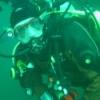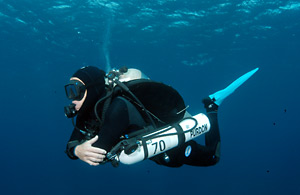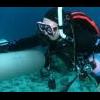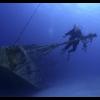
The Self Sufficient Diver
#1

Posted 23 August 2008 - 01:10 PM
I have been thinking about this for some time. The more I dive, the more I am convinced that a paradigm shift needs to be made in the way recreational divers are both equipped and trained. Traditional training says if you get in trouble "Look to your buddy". OK, not a bad thing necessarily and I am not saying we abandon the Buddy System as it has many advantages when it works. The problem is you end up reliant on the other person maybe even dependant in many cases. It is a solution that works as long as you have a buddy in the neighborhood or one even willing to help. However, the insta-buddy phenomena exists and you never know what you are going to get in the buddy lottery (Am speaking about non-SD trips, of course).
So lets reduce the importance of the buddy initially. Let's get Joe or Jill diver to the point where they can handle 95%+ of the issues and gear failures without a buddies assistance. We can still have the buddy around for insurance, but even if they disappear completely the diver is still fine and has a very good chance of getting to the surface safely on their own merits.
So essentially I am saying let us look at the training and equipment most OW divers get and see what we can do to improve it. Let's concentrate on two major problem areas.
LOA / OOA - According to DAN most people get serious injuries (DCS and lung over expansion) when trying to get to the surface in a CESA because of a LOA or OOA situation. The 'standard' solution in those cases is the OCTO from your buddy. To be clear, today's dive injuries are happening under the current buddy system. The well oiled buddy team in perfect sync with each other is an exception rather than a rule. How many stories have you seen of LOA/OOA situations where one guy says, "had to CESA because my buddy was too far away to reach and he wasn't looking at me."? OK, in that situation you don't have a buddy and this is where my point comes in. Low viz, complacency, currents and underwater features like reefs and wrecks continually conspire to separate buddies all the time. With Murphy's Law in full swing, bad things always happen at the worse time. If Diver A can handle the LOA/OOA situation by themselves then if there is a buddy separation, a slow and controlled ascent can be done and it does not result in injury.
How? Pony bottle. Yes, there are Spare Airs and doubles on either side of that solution and they are in no way invalid. Something is better than nothing. A Pony or Bailout Bottle is designed for one purpose. Getting a REC diver to the surface (Or at least a lot shallower) than they would ordinarily be. Pony size would depend on the depth or dive profile. Doubles are for more technical profiles requiring speciality training and overkill for OW divers in this example. Training could be simplified to the point of "Once you or your buddy are on your Pony, the dive ends..." Why? That is exactly what they say today about OCTO's. Replace one word with the other. Done...
A Pony with reg and second stage would allow a fully redundant system that can get a rec diver safely to the surface. A simple reg and bottle could be gotten for what, $200 or so? How many chamber rides, DCS hits and lung injury cases could be avoided if everyone had a bailout bottle? Another benefit: Now if your pony equipped buddy is in a LOA/OOA you don't have a wild eyed diver trying to claw your reg out of your mouth.
Now the paradigm shift. Responsibility must be placed squarely on the individual diver. They should be told that if you are in a LOA / OOA situation it is because YOU screwed up. You went too deep, didn't monitor your air, whatever. At the end of the day, your safety rests on your shoulders. Logically, if you got yourself into that situation then you should get yourself out of it. ...and that is the way they should handle it. Current training does not cover this (by standard) and they say if you are OOA go to your buddy. The buddy should become option number 2 with the onus on you as option #1. This lets a new diver know that they are in charge of their own destiny. Just because your new buddy Joe goes deeper and stays longer does not mean you are under an obligation to stay with him until you are OOA. Today the agencies simply say "stick with your buddy". How about "stick with your buddy until you reach the point where you have to leave to make a safe ascent to guarantee your own personal safety." Remember ~85% of divers only get the OW rating and never progress beyond that.
Basic Safety Gear - What does an OW diver truly need? Well, it depends on the conditions and water temp obviously for exposure suits, boots, etc. You cannot duplicate everything without complications and cost. However, can we distill their needs down to a bare list to handle issues? I think so.
How about: Whistle or air horn, time-piece, SMB (reel optional, but nice to have for free ascent SS), knife (X2 - primary and backup), flashlight (X2 - primary and backup) and mirror. Would cost under $200 for all that, but give a lot more chances of survival if things go wrong. These are minimums, by the way. Not saying you cannot carry other things or more lights, strobes, etc.
The key, in my mind at least, is to teach the diver to be self-reliant first wherever possible. Build redundancy into their gear as soon as practicable and let them know that responsibility and personal safety comes from them and not some faceless buddy.
[/SOAPBOX]
So what do you think?
Tech Support - The hard we do right away; the impossible takes us a little longer...
"I like ponies on no-stop diving. They convert "ARGH!! I'M GOING TO DIE" into a mere annoyance." ~Nigel Hewitt
#2

Posted 23 August 2008 - 02:11 PM
Y or H Valves also provide excellent redundancy without the need to carry additional tanks. The only additional component is an additional first stage (remove the octo from the first setup, and transfer to the second). Keeps the setup lighter and easier. Not the solution for more advanced dives, but a great alternative for a standard gear configuration for recreational diving.
"For the diligent diver, closed circuit rebreathers are actually safer than open circuit scuba." Tom Mount
#3

Posted 23 August 2008 - 02:49 PM
I usually carry a tiny 100' finger reel and a Carter PF-35 SMB, never needed 'em 'cos I've practiced free deco ascents religiously Just In Case. I can comfortably hover at 10 to 15' depth as long as needed, same with all the lower stops. (no official deco training BTW) I'm sure I've confused some of my dive partners in the past when I forgot to mention that I'd be doing deco stops on the way back up.
I've also had problems with rental or inexpensive dive gear, so I opt for the best I can get my hands on, and maintain it immaculately.
I'm always careful to check my tank pressure frequently, so OOA/LOA is gonna be a truly rare occurrence for me... never even come close after 130+ dives. I'd have to have a reg malfunction, which is possible but unlikely.
Yep, if it's possible I bring either a 6cf or 13cf pony on a trip. May not be DIR, but I don't give a hoot. I breathe less than a lot of other folks, so I can safely get to the surface from 120' on the 6cf bottle, even throwing in a few safety stops along to way to outgass. I've practiced with the 6cf bottle before, and had PLENTY of time to spare for all of the stops from a deep dive. Heavier breathers might need the 13cf bottle.
Instead of two knives, I carry a knife and a z-knife (I used to skydive, and they're wonderful for cutting lines.)
And unlike the prize idiot that left me alone on one of my earliest certified dives, I'll *never* do that to someone else unless they're endangering MY safety. I've had people freak at depth when things went wrong, but so far I've managed to calm 'em down and get their problems corrected (except for once when the guy bolted to the surface on me.) I'm just out there to have fun and see the sights, and I genuinely don't mind shepherding another newbie into the flock. We all had to start somewhere, and I'd like to spread MY joy at diving to the newbies.
#4

Posted 23 August 2008 - 04:38 PM
Knowing that on one of my dives on my last trip my dive buddy blew an o-ring at about 60 ft and we ascended together... I am now more conscious of what "might happen." I am also more aware of how much of my gear was probably hanging off of me unstead of clipped off/tied down (yep, I saw my gear in the trip video *shudder*).
So, I have a couple of questions for any takers... supposing I went the route of getting a pony bottle (for non SD trips!
#5

Posted 23 August 2008 - 04:46 PM
So far my experience is just with PADI so I'll have to just refer to them. I don't think that a major overhaul of standards needs to take place, the biggest problem with PADI standards as far as I can see is the somewhat "flexible" requirement that a student must show "mastery" of knowledge or a particular skill. That can lead to other factors such as time, money, student patience, instructor patience etc having an impact on the quality of the course, and producing a diver that meets standards but isn't comfortable with a certain skill or area of knowledge. E.G. when the course is rushed to fit it into the end of a vacation. That's my main gripe about standards really, that like laws they need to be enforced to be meaningful.
LOA / OOA - According to DAN most people get serious injuries (DCS and lung over expansion) when trying to get to the surface in a CESA because of a LOA or OOA situation. The 'standard' solution in those cases is the OCTO from your buddy. To be clear, today's dive injuries are happening under the current buddy system. The well oiled buddy team in perfect sync with each other is an exception rather than a rule.
Exactly, effective buddy teams as they are discussed on courses and in the pool are the exception rather than the norm. However I'd suggest that we fix that and find a way to change the culture of the buddy system rather than introducing more equipment, tasks and skills to the already jam-packed OW course. We should fix the underlying problem rather than add a piece of gear such as a pony bottle over the top of that. Once you add a pony bottle for instance you should really be calculating your rock bottom ascent pressure for you and your buddy, and that I think is a step to far to introduce to OW students. The Pony bottle is introduced during the Core Deep Dive of AoW which I think is an appropriate time to first talk about it as you can cover it in more detail than at OW.
I've never dived with a Pony and always consider my buddies tank as my alternate air source. I monitor their air just as closely as I do my own and the second that I am separated from that alternate air source I abort the dive. I won't do dives deeper than 20m without someone that I'm confident sharing air with in the group, and usually calculate their rock bottom for myself and abort the dive for them when they reach their rock bottom.
I guess I'm saying that provided the buddy system is understood and adhered to as it should be, perhaps with some minor modifications, it should be fairly resilient and offer the redundancy that is needed. Self sufficiency should be promoted but beyond simply redundant gear and encompassing the self sufficiency of the team not just the individual when it comes to elements such as navigation, dive planning, gas management etc. We needn't be kitted up to dive solo to address a problem that stems from people not following what they were taught on their courses.
EDIT: ... sorry jet-lagged ramblings
Edited by SquattingRadishDM, 23 August 2008 - 04:52 PM.
Ah, sir, live in the bosom of the waters! There alone is independence. There I recognise no masters! There I am free.
Jules Verne. 20,000 Leagues Under The Sea.
#6

Posted 23 August 2008 - 05:00 PM
I am also PADI trained...while it may be the number of years since I've had AOW combined with 12 years of not diving, I do not recall ever being introduced to the pony bottle during the deep dive.The Pony bottle is introduced during the Core Deep Dive of AoW which I think is an appropriate time to first talk about it as you can cover it in more detail than at OW.
I've never dived with a Pony and always consider my buddies tank as my alternate air source. I monitor their air just as closely as I do my own and the second that I am separated from that alternate air source I abort the dive. I won't do dives deeper than 20m without someone that I'm confident sharing air with in the group, and usually calculate their rock bottom for myself and abort the dive for them when they reach their rock bottom.
Thanks for the point about monitoring your buddy's air as closely as your own...something I will start paying attention to as I dive.
#7

Posted 23 August 2008 - 05:02 PM
I know I'm probably not self sufficient at this point in my diving... that's why I appreciate what everyone has said here so far. Just so I am understanding what is being said, help me with a few of the abbreviations being used.... SMB?.... CESA? (Controlled....Ascent?)... SS (Safety Stop?)
Knowing that on one of my dives on my last trip my dive buddy blew an o-ring at about 60 ft and we ascended together... I am now more conscious of what "might happen." I am also more aware of how much of my gear was probably hanging off of me unstead of clipped off/tied down (yep, I saw my gear in the trip video *shudder*).
So, I have a couple of questions for any takers... supposing I went the route of getting a pony bottle (for non SD trips!) and flew to some exotic locale, what measures would I need to take to travel with one, and what questions should I ask of the dive op about pony bottle fills? Also, where would be the (a) ideal place to keep a pony bottle as part of my dive gear (where do you clip it, or do you?)
SMB - Surface Marker Buoy - an inflatable buoy that is towed by the diver below to alert the surface where the divers are.
CESA - Controlled Emergency Swimming Ascent - Essentially an ascent at depth on one breath of air, keeping the airways open to avoid lung over expansion. You may find as you ascend that you can get a few more breaths out of your regulator as the pressure decreases.
I'm not sure about travelling with a pony but they are filled exactly the same as any other tank. Usually they are strapped to the main tank on your back, although upside down so that the valve is at the bottom and you can reach it easier behind your back rather than behind your head.
Ah, sir, live in the bosom of the waters! There alone is independence. There I recognise no masters! There I am free.
Jules Verne. 20,000 Leagues Under The Sea.
#8

Posted 23 August 2008 - 05:14 PM
I am also PADI trained...while it may be the number of years since I've had AOW combined with 12 years of not diving, I do not recall ever being introduced to the pony bottle during the deep dive.The Pony bottle is introduced during the Core Deep Dive of AoW which I think is an appropriate time to first talk about it as you can cover it in more detail than at OW.
I've never dived with a Pony and always consider my buddies tank as my alternate air source. I monitor their air just as closely as I do my own and the second that I am separated from that alternate air source I abort the dive. I won't do dives deeper than 20m without someone that I'm confident sharing air with in the group, and usually calculate their rock bottom for myself and abort the dive for them when they reach their rock bottom.
Thanks for the point about monitoring your buddy's air as closely as your own...something I will start paying attention to as I dive.
Ah, I'm just going off my AoW manual published in 2000 so not sure what it says these days. But there is a line in the deep chapter saying "you may want to consider a Pony Bottle...".... yeah thats about all it says so maybe you have something here shadragon
Ah, sir, live in the bosom of the waters! There alone is independence. There I recognise no masters! There I am free.
Jules Verne. 20,000 Leagues Under The Sea.
#9

Posted 23 August 2008 - 05:57 PM
1. Some water
2. A signalling mirror
3. EPIRB (emergency radio beacon - if you invest, go for one with built-in GPS)
4. A second SMB
5. Dye marker
6. Small Dive light
7. A strobe
8. A hat
Some divers put together what is known as a "Peleliu Pack" and attach it to a cam band. The name I believe came from a tragic episode in Palau where six divers surfaced within sight of their boat, but couldn't swim against the current to the boat, and the boat couldn't get their motor started. They were all lost.
For those who enjoy the freedom of diving without a wetsuit, I'd also think about survival on the surface. The only loss out of 4 in a similar episode in 2005 off Belize was the diver not in a wet suit.
Edited by Capn Jack, 23 August 2008 - 05:57 PM.
Jacques Yves Cousteau
#10

Posted 23 August 2008 - 06:19 PM
Thanks to ALL that has helped me learn a thing or two!!!
If you can't eat it or play with it,
Just pee on it and walk away.
#11

Posted 23 August 2008 - 06:54 PM
As an OW diver right out of classes, I would never have considered diving with just my buddy (certified same time I was) -- we just were not ready, and we knew it. We got about 60 dives logged, diving with boat groups with a dive leader in the water, before we were skilled enough to feel comfortable diving as a twosome with no one else around. There was safety in numbers, I suppose.
Now, I certainly won't complain about the practice part, because I love to dive and my skills have improved each trip I've taken, which makes my diving more enjoyable. And, I have yet to meet a diver who did NOT want to discuss their experiences and/or training with me, so listening (or reading, in the case of these threads) and learning from more advanced divers will also help me become a better and safer diver. Finally, education comes in many different forms, including advanced formal classes. To all newer divers, absorb all the info you can from other divers and go practice, but don't try to dive beyond your current skill level!
#12

Posted 23 August 2008 - 07:06 PM
They say that the most dangerous, or in this case, he who is the most danger is one who doesn't realize how much they do not know.
Daniel
Edited by mountainminnow, 23 August 2008 - 07:15 PM.
#13

Posted 23 August 2008 - 08:06 PM
"Compressed gas cylinders are allowed in checked baggage or as a carry-on ONLY if the regulator valve is completely disconnected from the cylinder and the cylinder is no longer sealed (i.e. the cylinder has an open end). The cylinder must have an opening to allow for a visual inspection inside."
"Our Security Officers will NOT remove the seal or regulator valve from the cylinder at the checkpoint. If the cylinder is sealed (i.e. the regulator valve is still attached), the cylinder is prohibited and not permitted through the security checkpoint, regardless of the reading on the pressure gauge indicator. Our Security Officers must visibly ensure that the cylinder is completely empty and that there are no prohibited items inside."
Once at your exotic locale I would give it to the dive shop and have them assemble and fill it. No idea if you need to fill/purge it a couple of times to remove standing moisture in the ambient air. They would know.
Pony's are not specifically taught on the PADI Deep Diver beyond a brief mention. They are certainly not promoted as much as I think they should be. Pony bottles are highlighted in the SDI Solo course though and an independent backup is required as a course equipment. You can attach them to your main tank as SDM described (That's the way I do it), but many people "sling" them using the D-ring on your hip and the D-ring on your chest strap to mount them. I found this gets in the way, but some people swear by it.

To be clear, a Pony is not a substitute for proper gas management. In a perfect world they would never be needed.
If it saves only one person a year from DCS or AGE then it is more than worth the trouble. DiveOps and resorts will come around soon enough. Many of the places I have been offer Pony's, but you have to ask for them, they are not offered or widely advertised.
Capn Jack makes an excellent point about surface survival. Remote possibility of being out alone after a dive, but like anything else, it can happen.
Tons of SCUBA abbreviations here... OOA - Out of Air, LOA - Low on Air... He missed FUBAR and SNAFU...
Tech Support - The hard we do right away; the impossible takes us a little longer...
"I like ponies on no-stop diving. They convert "ARGH!! I'M GOING TO DIE" into a mere annoyance." ~Nigel Hewitt
#14

Posted 23 August 2008 - 08:44 PM
Most places so far have filled my 6cf pony for free... if they fill 13 of 'em in a row, that's about like one 80cf tank, so it's a negligible cost to them. I've only seen them for rent ONE place I've dived (the tech operator on Bonaire). Most operators look at me like I'm stupid when I ask.
Try your little safety sausage in the ocean sometime. When I've practiced with them, I wasn't able to get 'em to stand up. I threw mine in the trash and switched to the Carter SMB because it seemed more reliable, and I could hang onto it and use it as an alternate in case the bladder in my BC blew a seam. It gives 35 pounds of lift, which is more than I've ever needed since I don't dive steel doubles.
It's been a while since that first 'buddy' upped and split on me, and I've had several cut and run at depth since then. At that point, the OW training agencies say you should surface and abort the dive. If you're comfortably self-sufficient, then you merely continue solo (like the jerk that just bolted on you is doing.) I've had that more often with East coast divers... dunno why they agree to buddy on the boat then go solo on the dive. Liars really piss me off. If you're the "same ocean" type, TELL ME! and I'll find someone else to dive with.
Don't get me wrong, I'm all for the buddy system! Anything that improves my chances of getting out of a huge problem at depth is a good thing. Based on my experiences, I can't afford to rely on 'em, so I make sure I can get myself out of any of the common (and most of the uncommon) incidents.
Yeah, I'd recommend the AOW class to anyone trained with PADI (I was myself). It contains concepts that some of the other agencies require in their basic classes. There's nothing wrong with educating yourself on how to enjoy the experience *safely*. I've also read up on deco procedures AND practiced 'em because whether you admit it or not, every dive is doing compression and decompression. I hope to not need deco procedures, but if I screw up horribly I can still get to the surface without a DCS hit.
------------------------
NOTE: my opinions are my own, and have utterly NO bearing on SD or trip operations. I'm just here to fix the broken stuff in the background; the 'admin' title is purely so I have the access to fiddle the gears on the server.
#15

Posted 24 August 2008 - 04:47 AM
There are differences in training and equipment that you get introduced to during training based on your instructor, where you are training, the agency, etc. Locally, the OW class and equipment is viewed as sufficient to do quarry dives, other local fresh water dives, go to the Caribbean, and take more classes. AOW is generally supplemented, and the goal is to be ready for a NJ wreck dive, without penetration. To get on a boat you'll need either a pony or doubles, etc. so you can rent a pony in almost any dive shop. Additional classes tend to introduce additional self sufficiency, depending on the class objectives. This makes sense due to the low vis you may encounter.
Obviously, if you live or train elsewhere your expectations of your classes will have to be adjusted. The thing to do is after each class have a long talk with your instructor about what classes you might want to take next, and the expectations you should have for those classes.
Edited by Geek, 24 August 2008 - 04:48 AM.
0 user(s) are reading this topic
0 members, 0 guests, 0 anonymous users




















